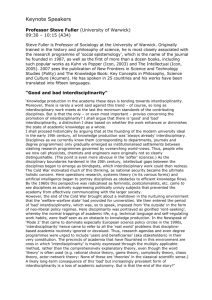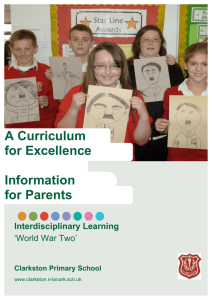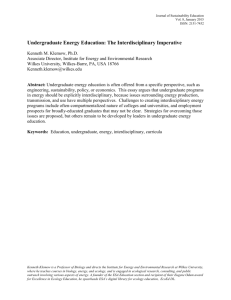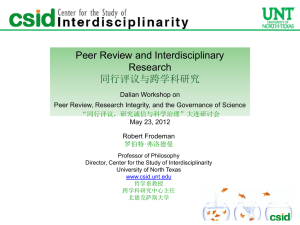The Power of Undergraduate Research
advertisement
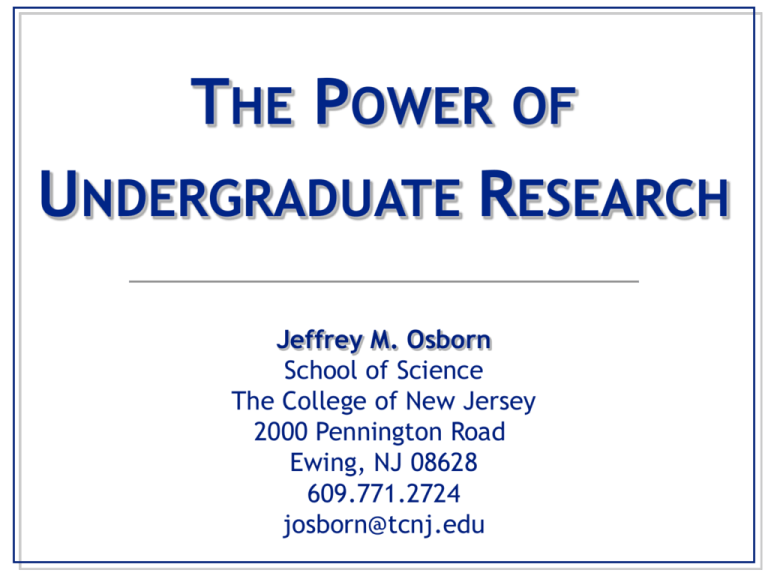
THE POWER OF UNDERGRADUATE RESEARCH Jeffrey M. Osborn School of Science The College of New Jersey 2000 Pennington Road Ewing, NJ 08628 609.771.2724 josborn@tcnj.edu COUNCIL ON UNDERGRADUATE RESEARCH www.cur.org CUR is an organization for faculty and administrators who believe that research is an important form of teaching COUNCIL ON UNDERGRADUATE RESEARCH Annual & Upcoming Meetings Biennial National Conference “Learning through Research: Dynamic Faculty, Students, and Institutions” June 24-26, 2006 DePauw University • Greencastle, IN Proposal Writing Workshop July 22-26, 2006 University of Richmond • Richmond, VA Institutionalizing UG Research Workshop October 13-15, 2006 Harvey Mudd College • Claremont, CA NATIONAL CONFERENCE ON UNDERGRADUATE RESEARCH (NCUR) www.ncur.org • An annual, student-oriented conference Over 2,000 student presentations • Open to all disciplines • Some lunch sessions for faculty and administrators • April 12-14, 2007 – Dominican University of CA INSTITUTIONAL CULTURE BENEFITS OF UG RESEARCH INTERDISCIPLINARITY FUNDING OPPORTUNITIES INSTITUTIONAL CULTURE • Student Engagement • Transformational Pedagogies • The Curriculum • Undergraduate Research as a Pedagogy • Definitions and Diversity • The Four Characteristics of UG Research • How to ‘Count’ UG Research • Making Connections INSTITUTIONAL CULTURE STUDENT ENGAGEMENT • Engaged forms of learning yield more educational effectiveness (transformational experiences) National Survey of Student Engagement Student Success in College: Creating Conditions that Matter (2005, Jossey-Bass & AAHE) Greater Expectations: A New Vision for Learning as a Nation goes to College (2002, AACU) Others (e.g., NSF, NRC, PKAL, HHMI, Carnegie, Kuh et al., Barr & Tagg, Guskin, Astin, Pascarella, etc.) INSTITUTIONAL CULTURE STUDENT ENGAGEMENT Cont. •Curricular, Co-curricular & Extra-curricular Student involvement Student-student interactions Student-mentor interactions Student-community interactions INSTITUTIONAL CULTURE TRANSFORMATIONAL PEDAGOGIES •Pedagogies of Engagement Undergraduate Research Internships Service Learning Study Abroad •Undergraduate Research INSTITUTIONAL CULTURE THE CURRICULUM • Learning-centered • Collaborative learning • Faculty as ‘teacher-scholars’ • The liberal learning landscape • Students: ‘intentional learners’ & ‘integrative thinkers’ • Context-rich & research-rich Teaching our disciplines in context Integration of teaching & research Discovery-based & problem-based experiences Credit for students & faculty (not just an ‘add-on’) INSTITUTIONAL CULTURE UG RESEARCH AS A PEDAGOGY • Research and teaching are not mutually exclusive • At a PUI, research is teaching! • UG research is not necessarily about ‘traditional’ outcomes (i.e., just the production, such as publications, etc.) • All disciplines can participate • “Research, scholarship and creative activity” http://src.truman.edu INSTITUTIONAL CULTURE DEFINITIONS & DIVERSITY • “Research, scholarship, & creative activity” in the campus discourse – developing a scholarly culture • Departmental and institutional faculty need to engage in a dialogue about what constitutes appropriate scholarly inquiry in the respective fields Observe models from both peer and aspirant institutions INSTITUTIONAL CULTURE DEFINITIONS & DIVERSITY Cont. • Developing an understanding and appreciation for diverse scholarly modes Attend presentations outside your discipline National Conference on Undergraduate Research (NCUR) • Investigative or inquiry-based experiences vs. Undergraduate research • Undergraduate Research Academic year Summer (full-time, full-immersion) INSTITUTIONAL CULTURE DEFINITIONS & DIVERSITY Cont. • 4 unifying characteristics of UG Research Mentorship Originality Acceptability Dissemination INSTITUTIONAL CULTURE THE FOUR CHARACTERISTICS 1) Mentorship • Collaborative • Serious Interaction • Clear goals • Focus on the student • Focus on the student learning process • Intellectual engagement by the student 2) Originality • Meaningful contribution by the student • Should be entirely or partially novel • It’s okay to reveal more questions than answers INSTITUTIONAL CULTURE THE FOUR CHARACTERISTICS Cont. 3) Acceptability • Employs techniques and methodologies that are both appropriate and recognized in the discipline • Includes a reflective/synthetic component that is appropriate to the discipline 4) Dissemination • There needs to be a final, tangible product for which both the process and results are peer-reviewed, critiqued, juried, judged, etc. INSTITUTIONAL CULTURE HOW TO ‘COUNT’ UG RESEARCH • Is it teaching, or is it scholarship? • It’s both! The mentoring component can be counted as teaching The outcome component can be counted as scholarship INSTITUTIONAL CULTURE MAKING CONNECTIONS • Rethinking disciplinary boundaries • Interdisciplinary modules, labs, courses & curricula • Interdisciplinary scholarship • Undergraduate & graduate programs/institutions 2-yrs, PUIs, Comprehensives, Doctorals, R1s • Academic, private & public sectors: Workforce development Building capacity Recent reports (Rising above the Gathering Storm; 2005, NRC) Getting the right people together, at the right place, at the right time INSTITUTIONAL CULTURE BENEFITS OF UG RESEARCH INTERDISCIPLINARITY FUNDING OPPORTUNITIES BENEFITS OF UG RESEARCH • Students • Faculty • Institution BENEFITS OF UG RESEARCH STUDENTS • Opportunity to put classroom knowledge into practice • Chance to better understand your discipline • Stimulation of creative & critical thinking • Ability to learn more independently • Chance to participate in new discoveries • Enhanced ability to understand the philosophy of life-long learning BENEFITS OF UG RESEARCH STUDENTS Cont. • Recognition by peers • Chance to be an academic role model • Opportunity to build a relationship with a faculty mentor • Identification of career interests • Increased chances for securing a job, and/or acceptance into a graduate or professional school • It’s fun! BENEFITS OF UG RESEARCH FACULTY • Chance to mentor quality students • Stimulation and confidence associated with creative & critical thinking • Excitement created by intellectual activity • Enhanced ability to remain current in one’s discipline and field • Integrating scholarship and teaching • Chance to improve your teaching • Internal and external recognition BENEFITS OF UG RESEARCH FACULTY Cont. • Chance to establish or re-invigorate a career • Chance to be an academic role model • Opportunity to establish collaborations with colleagues - interdisciplinary • Opportunity to promote and model life-long learning to students • Chance to breakdown barriers between faculty and students • It’s fun! BENEFITS OF UG RESEARCH THE INSTITUTION • Opportunity to enhance student learning • Opportunity to recruit and retain high-quality students • Opportunity to recruit and retain high-quality faculty • Opportunity to breakdown barriers between students and faculty • Opportunity to increase placement rates into graduate and professional schools, and the workforce BENEFITS OF UG RESEARCH THE INSTITUTION Cont. • Chance to breakdown barriers between teaching and scholarship - embracing the ‘TeacherScholar’ concept for the faculty • Intellectual enrichment of the baccalaureate degree • Enhancement of the reputation • Attracting external recognition • Attracting external funding • It’s fun! – increases morale INSTITUTIONAL CULTURE BENEFITS OF UG RESEARCH INTERDISCIPLINARITY FUNDING OPPORTUNITIES INTERDISCIPLINARITY • Context-rich and Research-rich Curriculum • Interdisciplinary Collaboration 2 PROGRAMMATIC EXAMPLES (Truman) Curriculum Enrichment Summer UG Research Experience On-campus Summer Experience Student & Faculty Voices Sustaining the Community Research Feeding the Curriculum INTERDISCIPLINARITY CONTEXT-RICH & RESEARCH-RICH CURRICULA • Opportunities Incorporate focused modules into existing courses Modify content and/or approach to pieces of existing courses Modify content and/or approach to the entirety of existing courses Discussion-based, seminar- or journal club-type courses Regular seminar, colloquium, and speaker series Mentored student projects Add entirely new courses Comprehensively revise entire curricula INTERDISCIPLINARITY INTERDISCIPLINARY COLLABORATION: TWO PROGRAMMATIC EXAMPLES • The Next STEP http://step.truman.edu Four partner institutions Truman State University Moberly Area Community College Metropolitan Community Colleges St. Charles Community College Bridge Program for Transfer Students Undergraduate Research Program Interdisciplinary Curriculum Enrichment Program INTERDISCIPLINARITY INTERDISCIPLINARY COLLABORATION: TWO PROGRAMMATIC EXAMPLES • Mathematical Biology Initiative http://mathbio.truman.edu Interdisciplinary undergraduate research projects Interdisciplinary course development Bi-weekly seminar INTERDISCIPLINARITY INTERDISCIPLINARY COLLABORATION: CURRICULUM ENRICHMENT • Interdisciplinary curriculum committee Teaching STEM in context Developing interdisciplinary modules, courses, and curricula Integrating research and teaching • Annual retreat Off-campus venue, with nice food & beverages Led by an external Facilitator Focused and topical Participants leave with an “agenda for action” INTERDISCIPLINARITY INTERDISCIPLINARY COLLABORATION: SUMMER UG RESEARCH EXPERIENCE • On-campus & Off-campus Options An array of off-campus partners in all STEM areas Missouri Botanical Garden Donald Danforth Plant Science Center University of Missouri, Columbia University of Missouri, Rolla The Boeing Company Mallinkcrodt Towers-Perrin Cerner Monsanto Sigma Aldrich, etc. INTERDISCIPLINARITY INTERDISCIPLINARY COLLABORATION: SUMMER UG RESEARCH EXPERIENCE • CC student participants Accommodations for non-traditional students Off-campus sites Child care (allowance, help, etc.) Housing issues, travel allowance • CC faculty participants Three each summer; one from each CC campus Stipend / R&B allowance Research supplies Travel to a conference Research support for home campus INTERDISCIPLINARITY INTERDISCIPLINARY COLLABORATION: ON-CAMPUS SUMMER EXPERIENCE • A coordinated, 10-week program that provides a cohesive set of structured activities designed to foster intellectual independence, professional and personal growth Proposal preparation and presentation, regular mtgs w/ mentors, research activity, weekly meetings, discussions, workshops and lunches, visiting speaker, field trip to off-campus research sites, end-of-summer symposium Summer schedule at: http://step.truman.edu • Building a community of scholars Summer Community Residence Hall Meals Small Group Meetings w/ Mentors Weekly Meetings, Discussions & Workshops Social Events Seminars & Field Trips INTERDISCIPLINARITY INTERDISCIPLINARY COLLABORATION: STUDENT & FACULTY VOICES • “At the start, I wasn’t thrilled by the statistics, but now that we have data, I can’t wait to get to it.” (student) • “I wish I could rewind my biology education and start it over in a way that had more mathematics.” (student) • “This has completely changed the way I view my work.” (faculty member) • “[With the addition of our CS collaborators] we’ve leaped an order of magnitude in what we are able to accomplish.” (faculty member) INTERDISCIPLINARITY INTERDISCIPLINARY COLLABORATION: SUSTAINING THE COMMUNITY • Academic year programs Ongoing mentored UG research projects during AY Monthly research-oriented workshops Bi-weekly Math-Biology Seminar Semesterly visiting speaker Semesterly field trips to stakeholders in the state • Comprehensive assessment plan Focused on both learning/development outcomes and tangible scholarly outcomes Data and instruments are integrated into the overall institutional assessment plan INTERDISCIPLINARITY INTERDISCIPLINARY COLLABORATION: RESEARCH FEEDING THE CURRICULUM • Development of new courses Introduction to Mathematical Biology Bioinformatics Programming for Scientists Others • Using data from UG research projects in existing and new courses & modules • Incorporating a problem-based similar theme into inter-departmental courses Diabetes model INSTITUTIONAL CULTURE BENEFITS OF UG RESEARCH INTERDISCIPLINARITY FUNDING OPPORTUNITIES FUNDING OPPORTUNITIES • Fund Raising & Grant Writing • Indirect Cost Policies • Strategic Investments • Academic Year Faculty Salaries • Internal Grant Programs (Faculty & Students) • Administrative Programs/Offices • Sustainability & Scalability FUNDING OPPORTUNITIES FUND RAISING & GRANT WRITING • Goal – Creating opportunities • Cultivating relationships Alumni & friends Local & regional businesses Private foundations & public agencies • Collaborations & Partnering Colleagues Partner & stakeholder groups Grants & Sponsored Research Office Development Office FUNDING OPPORTUNITIES FUND RAISING & GRANT WRITING Cont. • Writing grant proposals Intellectual benefits Collaborative & interdisciplinary proposals Submit and re-submit proposals Planning budgets carefully (faculty salary, student stipends, staff members, etc.) Use of direct funds Creative uses of indirect costs (leveraging other resources and supporting and building the culture) Indirect cost policies (models) FUNDING OPPORTUNITIES INDIRECT COST POLICIES • Review existing policies • Shared distribution models President, Vice President, Dean President/VP, Dean, Department VP, Dean, Department, PI • Faculty incentive models Proportions to institution & PI PI proportion split to direct costs & salary supplement FUNDING OPPORTUNITIES STRATEGIC INVESTMENTS • Pay new (& continuing) faculty some summer salary to arrive early and write an external grant proposal • Take faculty to visit funding agencies and program officers FUNDING OPPORTUNITIES USING ACADEMIC YEAR FACULTY SALARY FROM GRANTS • Establishing guidelines & policies • Creative models Flexibility Percentages of “buy-out” Pooling AY salaries from multiple investigators to fund a ‘teacher-scholar’ postdoc position(s) FUNDING OPPORTUNITIES INTERNAL GRANT PROGRAMS: FACULTY AWARDS • Supplies, travel, equipment, software, etc. • Stipends for students • Summer salary/stipends for faculty • Collaborative with students • Competitive • Can be defined as a “seed” program FUNDING OPPORTUNITIES INTERNAL GRANT PROGRAMS: STUDENT AWARDS (STIPEND-BASED) • Summer • Full-time • Immersion-type experience • Sources Direct budget line Indirect costs Development funds (e.g., Biology Alumni Research Stipends - BARS) FUNDING OPPORTUNITIES ADMINISTRATIVE PROGRAMS • Grants Office Newsletters Boilerplate language • Instructional Technology Center • Faculty Development Office • Undergraduate Research Office FUNDING OPPORTUNITIES SUSTAINABILITY & SCALABILITY • • • • • • • • Projects that are people-specific are hard to sustain Clear definitions of both the goals and processes need be known and embraced by all leadership teams Ownership by all stakeholders is needed Share outcomes and student testimonials (succinctly) Partnerships and collaborations are critical Remaining focused on the goals Intentionally consider the adaptability and scalability of the project from the outset Seeking outside advice, counsel, and peer review (advisory boards, program reviews, etc.) INSTITUTIONAL CULTURE BENEFITS OF UG RESEARCH INTERDISCIPLINARITY FUNDING OPPORTUNITIES INSTITUTIONAL CULTURE INSTITUTIONAL FOCUS & MISSION • Incorporating substantive academic issues, discussion, and reflection into the institution’s culture Engagement vs. busyness and over-scheduling Meeting agendas & frequencies Program reviews, retreats, workshops (agendas for action) An atmosphere of ‘creative tension’ & risk-taking (balanced) AN INSTITUTIONAL CULTURE • Developing a new culture that embraces undergraduate research, student engagement, curricular innovation, interdisciplinary collaboration, and deep faculty engagement can only occur when it has broad, grass-roots involvement of the faculty and is buttressed by strong administrative support. • Building a shared vision! • It’s an evolution!
